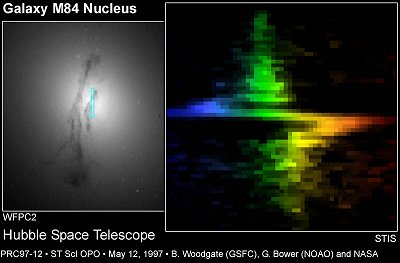3C272.1 = B1222+131 = M84 = NGC4374

Observations of the spectrum of the nuclear region of M84 with the Hubble Space Telescope's Imaging Spectrograph (STIS) show evidence for fast rotation of a disk of gas at the center of the galaxy. The STIS spectrum (right panel), taken across the region marked in light blue in the WFPC2 optical image (left panel), shows an increase in velocities up to a peak of 400 kilometers per second 8 parsecs (26 light-years) from the galaxy's center. The left side of the spectrum displays the shorter wavelengths (light emitted by gas that is moving towards us relative to the center of M84); longer wavelengths (light shifted further to the red because it is moving away from us faster than the center of M84) are to the right. The "zig-zag" pattern in the spectrum shows a rapid increase in the gas motions closest to the center of the galaxy, providing evidence for a large central mass.
If most of the mass in a galaxy's core is entrapped in a black hole, the disk of gas surrounding the black hole rotates differentially, with the gas closest to the black hole circulating fastest (just as the Solar System planets orbit the Sun at different speeds depending on their distances). Assuming that this is the correct explanation for the observed velocity "zig-zag" in the spectrum, the rotation velocities and extent of the gas can be used to estimate the central mass, using Kepler's laws of orbital motion.
The motions in the nuclear region of M84 indicate a black hole containing between 90 and 260 million solar masses.
The radio source is believed to be powered by winding up magnetic fields in the inner part of the
gas disk, a process that can accelerate fast-moving particles and magnetic fields along the rotation axis of the disk and thus launch the radio jets.
Click on the picture above to see a higher-resolution version.
Massive black holes are a common feature of galactic nuclei. Extended radio galaxies such as 3C272.1 are produced when rotating gaseous disks threaded by magnetic fields form around these black holes. This process occurs in many elliptical galaxies but appears to be extremely rare, if not actually forbidden, in spiral galaxies.
For further details about the detection of the black hole, see
"Kinematics of the Nuclear Ionized Gas in the Radio Galaxy M84 (NGC 4374)"
by G.A.Bower, R.F.Green, A.Danks, T.Gull, S.Heap, J.Hutchings, C.Joseph, M.E.Kaiser, R.Kimble,
S.Kraemer, D.Weistrop, B.Woodgate, D.Lindler, R.S.Hill, E.M.Malumuth, S.Baum, V.Sarajedini, T.Heckman,
A.S.Wilson, and D.O.Richstone, Astrophysical Journal, 492, L111
(1998).
 Go back to:
Go back to:
Last updated: 1999 September 13, 15:39 EDT
 Go back to:
Go back to:

 Go back to:
Go back to: